The goal of every manufacturer is to produce goods in the fastest manner possible with the lowest volume of quality rejections. This drives profit and keeps companies competitive within their markets.
But modern manufacturing is complex. Each task or process in the work sequence may be tied to several others upstream and downstream from the task at hand. This means that all procedures in the production process must be completed in the most efficient and consistent manner possible.
Companies use several methodologies for continuous improvement to ensure this consistency and efficiency, including lean manufacturing, Six Sigma, and others. In each of these methodologies, standard work is a core component.
Using accurate production data, manufacturers can not only enable their standard work, but ensure that it is as accurate, reliable, and up-to-date as possible.
What is Standard Work?
Standard work is defined as completing tasks or processes using best practices. Standardized work can drive customer satisfaction, optimized efficiency, lower costs, higher quality, and the highest possible degree of safety.
Standard work must be clearly documented for each work sequence in the production process. This documentation must be accessible to ensure anyone performing the task can do so consistently.
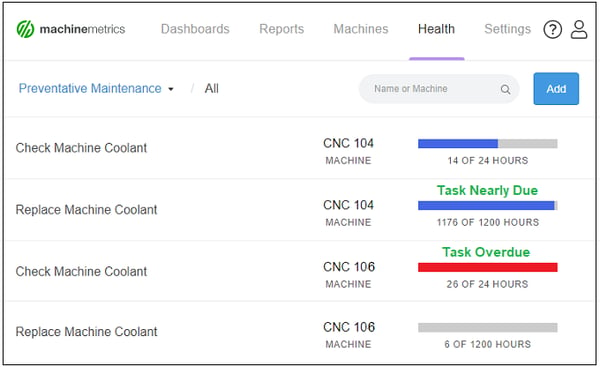
3 Elements of Standard Work
There are three key elements of standard work:
Takt Time
In all continuous improvement methodologies, takt time is the rate, measured in seconds, minutes, or hours, needed to complete a part and meet an order status. A watch or digital/analog machine counter may be used to record takt time manually for later analysis.
Learn how to calculate and reduce takt time >>>
The countdown timer is embedded into the process using a production monitoring platform like MachineMetrics. It can be displayed on HMIs and mobile devices such as tablets, laptop screens, or large monitors that display ongoing production status.
Workflow
The workflow represents the exact work sequence and procedures required to complete the part correctly and within the established takt time. The workflow may be written in a flowchart and may use pictures, diagrams, and other visual aids to help users understand the steps clearly.
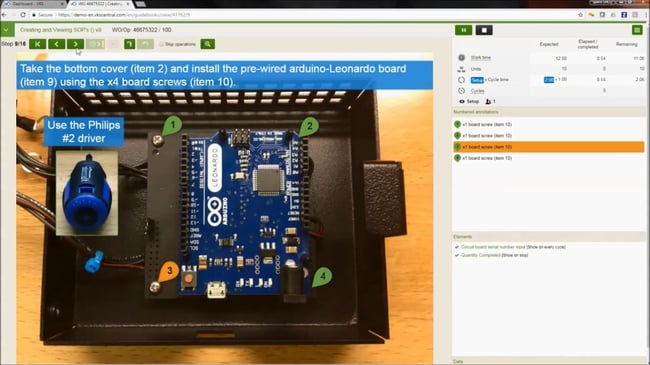 An example of digital work instructions from VKS. [Source]
An example of digital work instructions from VKS. [Source]
These visual aids may be stationed at each workstation in manual continuous improvement. However, with platforms like MachineMetrics, workflows are dynamic and available at any interface. The MachineMetrics platform uses real-time data and actual machine conditions so that the workflow and associated countdown timers reflect current conditions.
Key metrics such as production efficiency, total part time, actual part time, and average part time are displayed with current data and conditions. Because data is contextualized and available in easy-to-read graphics and reports, operators and managers can optimize processes at the point of use.
This ensures that the reality is reflected in assumptions and projections to ensure planning is accurate and feasible.
Standard Inventory
Inventory optimization is essential in lean manufacturing, and standard work means having the correct amount of stock required to complete the job within the established takt time.
Standard inventory includes suitable raw material feedstock, including units or blanks within the machine. It also assumes WIP between processes for the next downstream job step.
The Advantages of Standardized Work
Standard work has many benefits. It helps give managers a better understanding of true production time and can be used to provide training to new employees. It instills best practices in the corporate culture and eliminates tribal knowledge in favor of digitally documented and repeatable processes.
Further, by using a machine monitoring solution to collect accurate production data, managers can ensure that production standards are updated continuously. This ensures that performance can be measured against existing benchmarks and planning can be more accurately prepared.
Plug-and-play Machine Connectivity
Other key benefits of standardized work processes include:
Less Variability
Variability in processes is a concern for any industry. Customer satisfaction suffers if products aren’t consistent in performance characteristics, specification, quality, and other variables. Standardized work creates a format for consistent production processes. This is especially important in industries like CNC machining, where precision for medical, defense, and aerospace sectors requires tight tolerances.
With MachineMetrics, critical KPIs are displayed in real-time. This enables operators, technicians, and managers to access them and correct any issues before variation occurs. Alerts and alarms can also be added to notify appropriate staff when variance occurs.
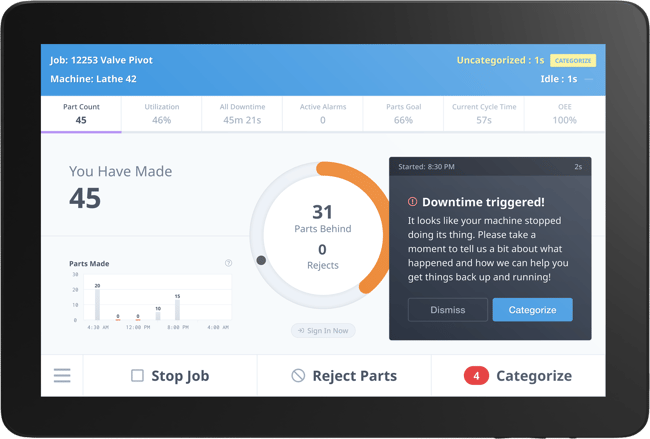
Focus on Process Rather than People
Standard work focuses on the process rather than the people. It’s a means of introducing best practices that help train an employee and instill continuous improvement and performance to an established cycle time as part of a culture.
Because platforms like MachineMetrics update and adjust workflows using real-time machine and operator data, standard work becomes a dynamic tool for improvement rather than a performance sword hanging over operators' heads.
Continuous Improvement
Continuous improvement is at the heart of lean manufacturing and Six Sigma methodologies. Most companies have an ongoing continuous improvement initiative to drive more process changes throughout the enterprise. Standard work focuses on consistent best practices for each job process, making it essential for continuous improvement initiatives.
With MachineMetrics, advanced workflows and current KPIs use actual machine conditions and real-time data to update standard work requirements. Real-time data allows for continuous improvement to be indeed continuous, drawing on the data and information supplied by connected devices.
Dynamic reporting also helps managers and operators identify the root causes of problems. Changes can be made and added to the system's parameters to sharpen the standard work documentation.
Consistent Production with High Quality
Traditional manufacturing required a lot of tribal knowledge, which meant that operators often made decisions based on "feel." This type of production meant different levels of knowledge, understanding, and methodologies between machines, shifts, and employees. These inconsistencies can result in different throughput levels, lower quality, unplanned downtime, and higher costs.
Standard work uses best practices to get the job done. These practices require clear and understandable documentation and pictures, diagrams, and other tools to ensure that the process is run consistently. By applying consistent production methods, cycle time, takt time, quality, and output can be replicated regardless of the operator, machine, or shift.
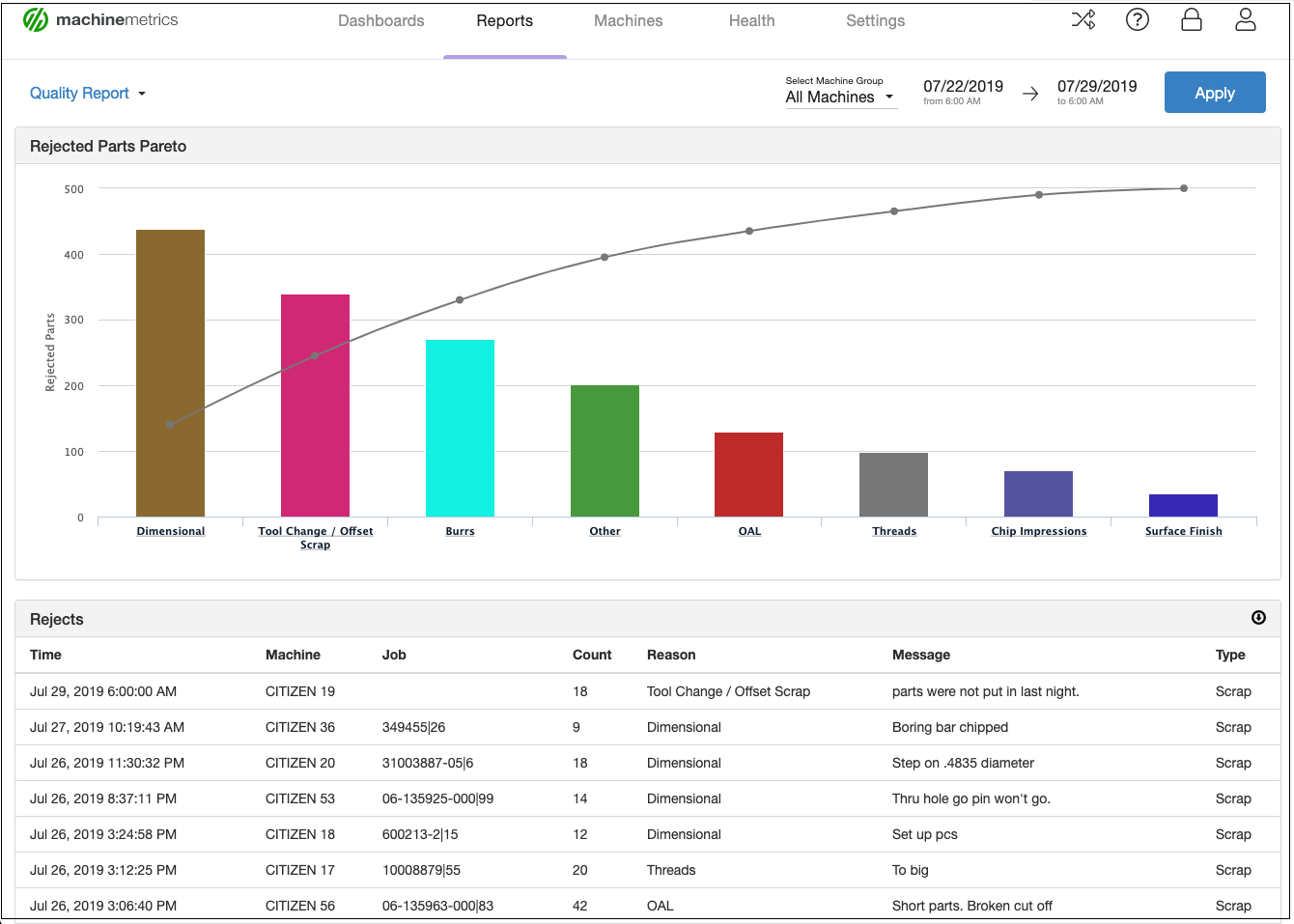 A rejected parts pareto from MachineMetrics displays the most common reasons for quality defects. Managers can use this information to adjust processes, updating standard work to reflect what is actually happening on the shop floor.
A rejected parts pareto from MachineMetrics displays the most common reasons for quality defects. Managers can use this information to adjust processes, updating standard work to reflect what is actually happening on the shop floor.
Enhanced Efficiency
When operators are trained to use the same accurate, real-time documentation to complete a task, tribal knowledge, "feel" intuition, and other uncontrollable variables are replaced by measured and documented processes.
When a process is out of line, changes can be made quickly. The MachineMetrics platform automatically uses real-time operator and machine conditions to adjust workflows and standard work documentation. It allows managers and other continuous improvement project managers to implement more extensive changes when required.
Waste Reduction
Standard work reduces waste by eliminating the variances between operators and explicitly listing the best practices required to complete each task. As downtime, efficiency, and training improve, there are fewer chances of defects.
While standard work documentation will eliminate waste to a certain point, data collection and analysis of machine conditions and operator contextual data allows users to more accurately document issues, and even predict them altogether.
6 Stages of Standardized Work
Now that we’ve covered the elements and benefits of standardized work, we’ll look at the implementation process as part of a continuous improvement plan or adoption of a lean manufacturing methodology:
- Gather Data on Current Operations: You can't understand where to start without understanding where you are. One great way to gather data is to establish a baseline of production. By measuring current takt time, cycle time, machine speeds, quality KPIs, throughput, and OEE, you can identify where you are in current production.
- Take Note of Differences and Problems: A diverse team of operators, technicians, maintenance, management, and administrative staff can help identify problem areas. These may be differences in shift output, training levels, quality from machine group to machine group, and other variables. Consider any problems that inhibit or reduce efficiency and production.
- Determine the Most Efficient Approach to Your Business: Every business is different, and some companies have the resources to proceed with the entire operation. Others may deem that incremental ways of progress are better given available resources and time. The goal is to determine a path that isn’t too broad or narrow for your company's capabilities and matches what can be realistically accomplished to deliver the best results.
- Keep Track of Everything: Use a project timeline to document everything from the team meetings. This includes KPIs, notes, surveys, equipment technical specifications, job specifications, training levels, and available resources. Keeping track of everything means that your final documentation won’t have gaps and will consist of best practices that optimize each job step.
- Make Changes to Your Training Programs: Standard work is part of a cultural change. It means that everyone is committing to performing each task the same way. This must be included in training programs for all new staff and any retraining required for current staff who may be reluctant to let go of tribal knowledge and gut feel.
- Consistently Strive to Raise the Bar: Continuous improvement must have standardized work as its core component. And with the digital tools available from best-in-class systems such as MachineMetrics, continuous improvement can be truly continuous. Job standards can be updated in real-time and system optimization can be deployed quickly. Drilling down with these tools at hand means manufacturers can achieve a level of efficiency and control that wasn’t possible in the past.
Using MachineMetrics to Develop Accurate Work Standards
The MachineMetrics platform uses real-time machine and operator data to develop accurate, reliable work standards. Manual data collection solutions simply don't cut it. Instead, relying on production data directly from machines ensures that operators, managers, and management systems can enable decision-making and automation based on accurate information.
Learn more about optimizing job standards with MachineMetrics or book a demo to see it in action.


.png?width=1960&height=1300&name=01_comp_Downtime-%26-Quality_laptop%20(1).png)



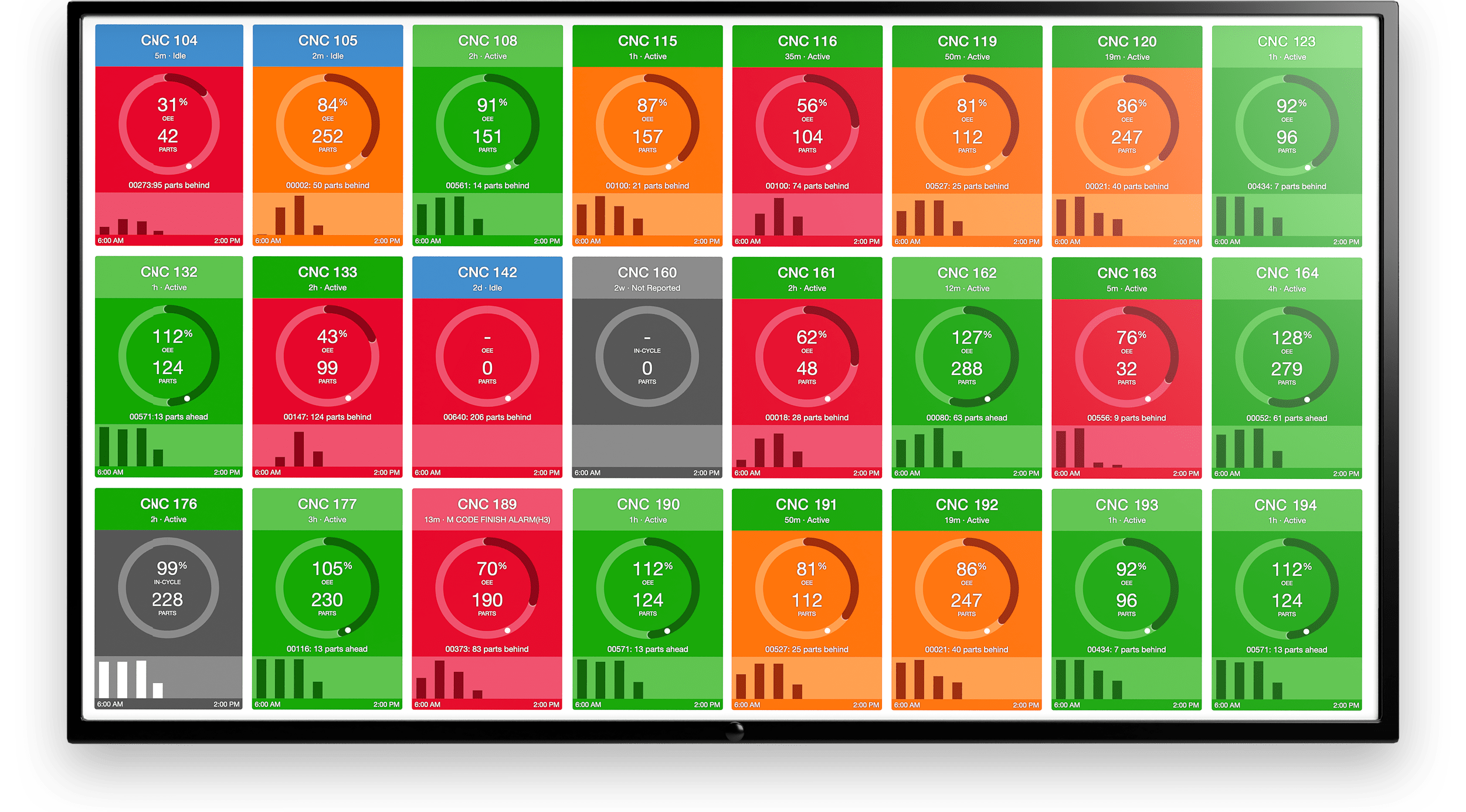











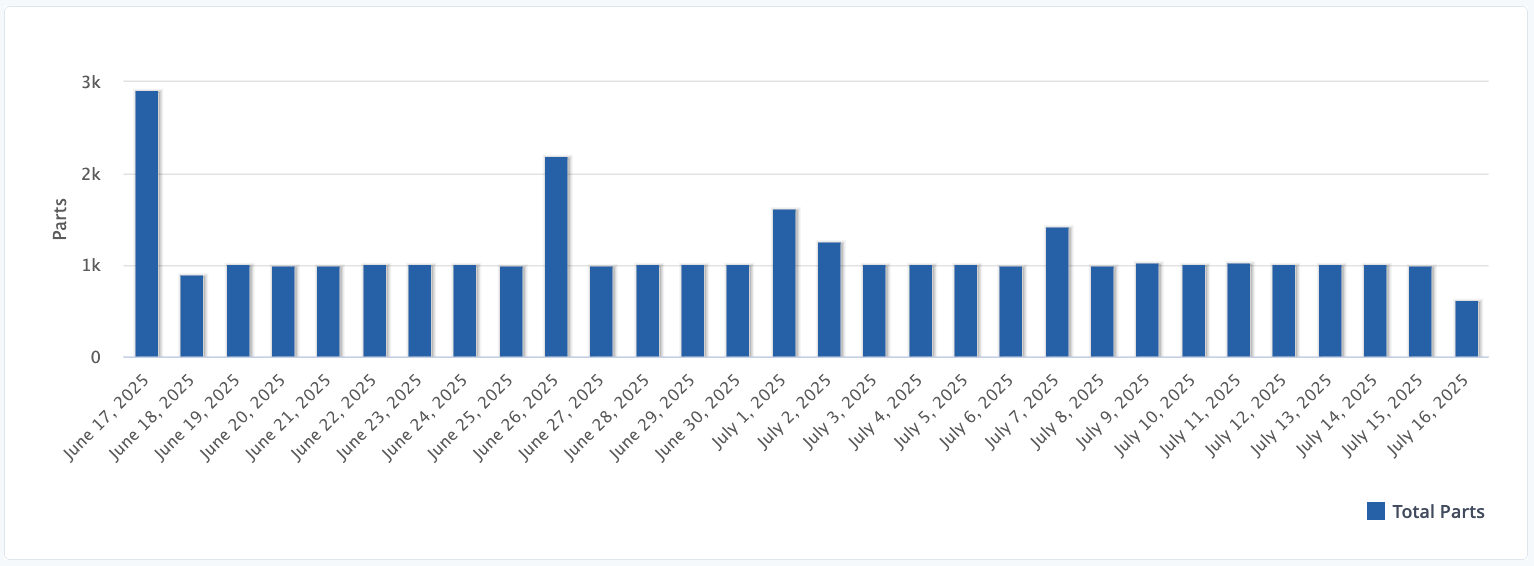
Comments